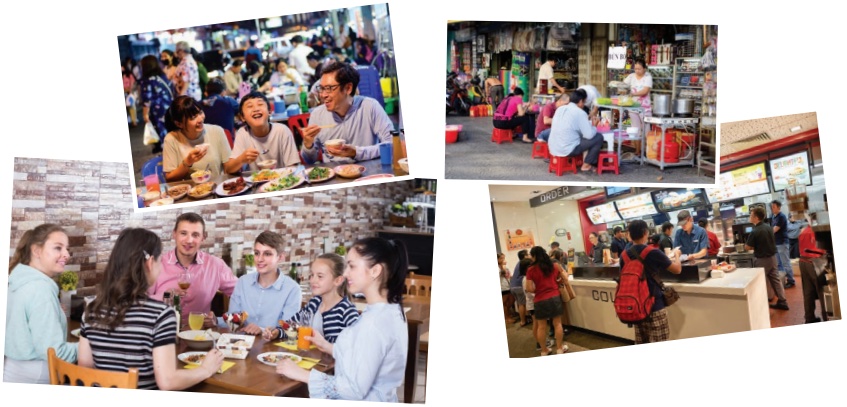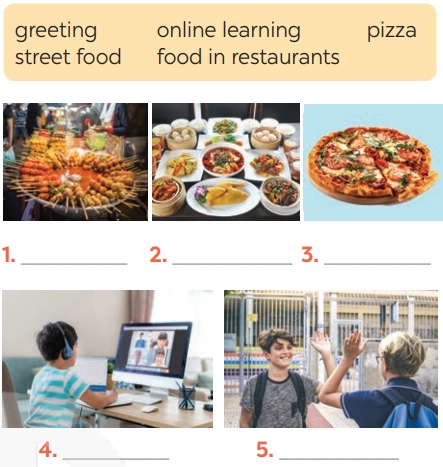Tiếng Anh 8 - Global Success
Unit 6: Lifestyles
Getting Started
1. Listen and read.
(Nghe và đọc.)
Nam: Hello, Tom. How're things?
Nam: Xin chào, Tom. Mọi thứ thế nào?
Tom: Oh good. I like it here. The lifestyle is interesting and different from that in my country.
Tom: Ồ tốt. Tôi thích nơi này. Phong cách sống ở đây thú vị và khác biệt so với ở đất nước tôi.
Nam: Really?
Nam: Thật sao?
Tom: Sure. Students here call their teachers by their title "teacher", not by their names.
Tom: Chắc chắn rồi. Học sinh ở đây gọi giáo viên của mình bằng chức danh "giáo viên", không phải bằng tên.
Nam: Right. How do you greet your teachers?
Nam: Đúng rồi. Bạn chào giáo viên của mình như thế nào?
Tom: We usually say "Hello" or "Good morning" then Mr, Mrs, or Miss and their surnames, for example "Good morning, Mr Smith."
Tom: Chúng tôi thường nói "Xin chào" hoặc "Chào buổi sáng" sau đó là Ông, Bà hoặc Cô và họ của họ, ví dụ như "Chào buổi sáng, Ông Smith".
Nam: Are there other differences?
Nam: Có sự khác biệt nào khác không?
Tom: People buy and sell a lot of street food here. In my country, people usually buy food in a store or a restaurant.
Tom: Mọi người mua và bán rất nhiều đồ ăn đường phố ở đây. Ở đất nước tôi, mọi người thường mua đồ ăn ở cửa hàng hoặc nhà hàng.
Nam: Yeah. Buying street food is a common practice in my city.
Nam: Vâng. Mua đồ ăn đường phố là một hoạt động phổ biến ở thành phố của tôi.
Tom: And I've noticed that many people have breakfast on the street too! In my country, we typically have a light breakfast at home.
Tom: Và tôi nhận thấy rằng nhiều người cũng ăn sáng trên phố! Ở đất nước tôi, chúng tôi thường ăn sáng nhẹ ở nhà.
Nam: I see. But here many adults are in the habit of having breakfast outside of their homes. If they're not in a hurry, they'll even have a leisurely coffee there.
Nam: Tôi hiểu rồi. Nhưng ở đây, nhiều người lớn có thói quen ăn sáng bên ngoài nhà. Nếu họ không vội, họ thậm chí còn nhâm nhi một tách cà phê ở đó.
Tom: That's fascinating!
Tom: Thật hấp dẫn!

Hướng dẫn giải
2. Read the conversation again and complete the table.
(Đọc lại bài hội thoại và hoàn thành bảng.)
In Nam’s country
- Students greet teachers by their title.
- People eat breakfast (2) ......
- People buy and sell food on the roadside.
In Tom’s country
- Students refer to their teachers as Mr, Mrs, or Miss and their teachers' (1) ......
- People eat breakfast at home.
- People often buy food in a (3) ......
Hướng dẫn giải
()
In Nam’s country
(Ở đất nước của Nam)
- Students greet teachers by their title.
(Học sinh chào giáo viên bằng chức danh)
- People eat breakfast (2) on the street.
(Mọi người ăn sáng trên đường.)
- People buy and sell food on the roadside.
(Mọi người mua và bán đồ ăn ở hai bên đường.)
In Tom’s country
(Ở đất nước của Tom)
- Students refer to their teachers as Mr, Mrs, or Miss and their teachers' (1) surnames.
(Học sinh sẽ gọi giáo viên theo Mr, Mrs hoặc Mrs và họ của giáo viên.)
- People eat breakfast at home.
(Mọi người ăn sáng ở nhà.)
- People often buy food in a (3) store or restaurant.
(Mọi người thường mua đồ ăn trong cửa hàng và nhà hàng.)
3. Complete each sentence with a word or phrase from the box.
(Hoàn thành các câu sau với một từ hoặc cụm từ trong hộp.)
greet
practice
serve
lifestyle
in the habit of
1. A balanced diet and exercise are important for a healthy ......
2. Handshaking, bowing, and hugging are some of the ways in which people ..... one another.
3. Waiters and waitresses ..... food in restaurants.
4. Going out for breakfast has become a common ..... in this city.
5. My mum is ..... keeping everything in the kitchen bright and clean.
Hướng dẫn giải
- greet (v): chào hỏi
- practice (n): phong tục
- serve (v): phục vụ
- lifestyle (n): lối sống
- in the habit of - N: có thói quen
***
Chi tiết
***
1. lifestyle
2. greet
3. serve
4. practice
5. in the habit of
1. A balanced diet and exercise are important for a healthy lifestyle.
(Một chế độ ăn cân bằng và tập thể dục rất quan trọng cho một lối sống khỏe mạnh.)
2. Handshaking, bowing, and hugging are some of the ways in which people greet one another.
(Bắt tay, cúi chào và ôm nhau là một vài cách để một người chào người khác.)
3. Waiters and waitresses serve food in restaurants.
(Phục vụ nam và nữ phục vụ đồ ăn trong nhà hàng.)
4. Going out for breakfast has become a common practice in this city.
(Ăn sáng ở người trở thành một phong tục phổ biến ở thành phố này.)
5. My mum is in the habit of keeping everything in the kitchen bright and clean.
(Mẹ mình có thói quen giữ cho mọi thứ trong nhà bếp sạch và sáng bóng.)
4. Label each picture with a word or phrase from the box.
(Điền vào mỗi bức tranh một từ hoặc cụm từ trong hộp.)

Hướng dẫn giải
1. street food: ẩm thực đường phố
2. food in the restaurant: đồ ăn trong nhà hàng
3. pizza: bánh pizza
4. online learning: học trực tuyến
5. greet: chào
5. Greetings around the world. Take the quiz.
(Chào nhau trên khắp thế giới. Giải câu đố.)
1. Which is probably the most common way of greeting around the world?
A. Shaking hands.
B. Sticking out one's tongue
2. In the USA, people greet each other by ......
A. shaking heads
B. saying "Hello"
3. Thais greet their elders by saying "sawadee" and ......
A. saying their surname
B. slightly bowing to them
4. The Maori of New Zealand greet each other by ......
A. kissing each other's cheek
B. pressing their noses together
5. How do people in Japan normally greet each other?
A. They bow to each other.
B. They hug each other.
Lời giải
1. Which is probably the most common way of greeting around the world? Shaking hands.
2. In the USA, people greet each other by saying "Hello".
3. Thais greet their elders by saying "sawadee" and slightly bowing to them.
4. The Maori of New Zealand greet each other by pressing their nose together.
5. How do people in Japan normally greet each other? They bow to each other.
Xem bài khác:
Unit 6: Lifestyles
Tiếng Anh 8 - Global Success